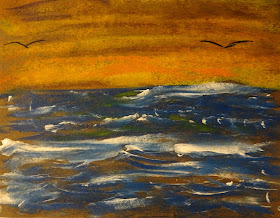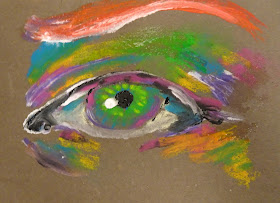Nevertheless, it was a great workshop, with everyone creating enthusiastically. All photos in this post are pieces created by the workshop participants. I was blown away by the work they did!
In the workshop, we mostly used bogus paper, an inexpensive and highly absorbent thickly fibrous ugly gray paper. I purchased it through Nasco but it can also be purchased elsewhere. I soaked the bogus paper in a tub of water. Workshop participants used a variety of soft pastels drawing directly onto the surface of the wet paper. The chalk pastels become paint-like on the wet surface, creating luscious vivid color!
A second technique was to paint lines in black acrylic on white (or bogus) paper. Then, areas of the paper could be painted with water, and colored with chalk.
Or, chalk could be colored and then blended with liquid starch, using your finger, a paintbrush, or a Q-tip.
An additional technique is called 'chalk dips', and was done on colored or black paper. Participants dipped their chalk pastel sticks in white tempera paint and worked in bold strokes of chalk. The paint 'outlines' the chalk color, as in the photos below. Any color tempera can be used for this technique.
My favorite thing that happened in the workshop was the way the participants combined the various techniques and materials. Chalk dips were added to the chalk drawings on wet bogus paper, and on the white paper with liquid starch.
And some people combined the chalk on wet bogus, the white tempera chalk dips, and also added the black acrylic. Can't you see some of these pieces, such as the ones below, re-interpreted as giant abstract paintings in oil or acrylic?
When the pieces dry, they will turn chalky again (unless the colors were blended with liquid starch, which 'fixes' the chalk). To restore the vibrancy of the colors and prevent the dry chalk from smearing, you can paint over the artwork with Mod Podge, or some other acrylic gloss varnish (or also Sax Gloss Tempera Varnish) to seal them. But this needs to be done carefully to prevent smearing the chalk. I recommend painting the gloss over one chalk color at a time, and rinsing/wiping the brush in between colors.
Here's a few more pieces from the workshop.





























These are some very interesting techniques! I'm definitely gone to try them. By the way, I am South African, I don't know what "bogus" paper is!
ReplyDelete